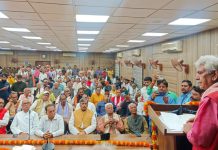A partial solar eclipse will be visible on the western horizon shortly before the sunset on Tuesday. Sky watchers in several parts of India will be able to witness the phenomenon, which occurs when the Moon is positioned between the Sun and the Earth, for a short span of time. In the case of a partial solar eclipse, the Moon covers only some areas of the Sun’s disc.
In view of the partial solar eclipse, the Badrinath and Kedarnath temples have closed their doors for the day.
Here’s what you need to know:
How long will the partial solar eclipse last?
The total duration of the partial solar eclipse is 1 hour, 39 minutes and 31 seconds. Since it’s a partial solar eclipse, the fraction of the Sun’s disc that the Moon will cover will differ depending on what part of the planet you view the phenomenon from.
The maximum eclipse fraction of the Sun will be witnessed in Russia. In India, the highest eclipse fraction will be visible from northern regions, including Leh in Ladakh and New Delhi. The path of the partial solar eclipse can be viewed here.
When and where to watch the partial solar eclipse?
According to the Indian Institute of Astrophysics (IIA), those in New Delhi will witness a 44% eclipse fraction. The eclipse will start at 4.29 pm and the maximum fraction will be visible at 5.30 pm. In Mumbai, an eclipse fraction of 25% will be visible, starting from 4.49 pm.
The table below shows the time for when the eclipse will start and achieve maximum fraction in various cities of India.
 Location-wise partial solar eclipse in India. (Source: IIA, Bengaluru)
Location-wise partial solar eclipse in India. (Source: IIA, Bengaluru)
How to view the solar eclipse from home?
The Aryabhatta Institute of Observational Sciences (ARIES), Nainital, (https://www.youtube.com/channel/UCG2LKvORv_L2vBL4uCuojnQ) and the Indian Institute of Astrophysics (IIA), Bengaluru, (https://www.youtube.com/watch?v=evJBhD-Oigc) will live stream the partial solar eclipse on their YouTube channels from 4 pm onwards. The IIA Bengaluru will stream the eclipse as viewed from the Indian Astronomical Observatory at Hanle, Ladakh.
How to view the solar eclipse safely?
In order to catch a glimpse of the solar eclipse, you must have an unhindered view of the western horizon before the sun sets.
It’s unsafe to view the eclipse with naked eyes or with a telescope or binoculars. It can be viewed through eclipse glasses or with a pinhole projector.



